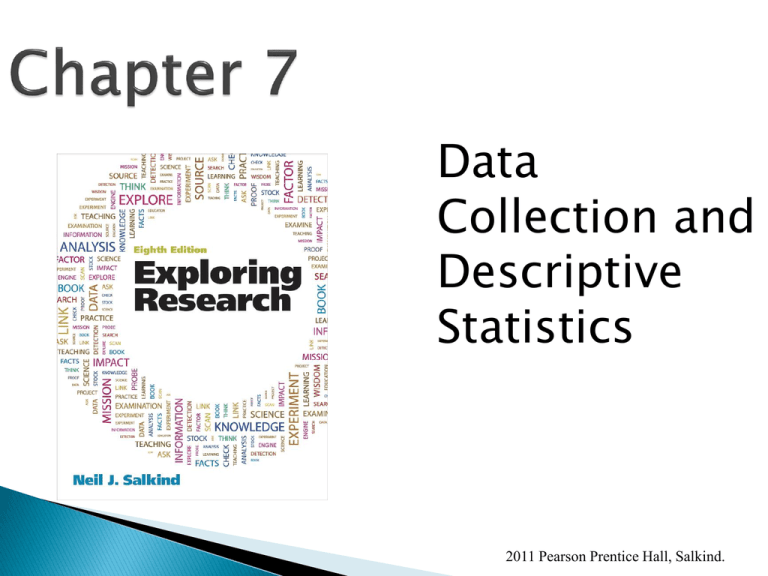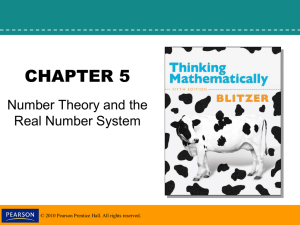
Data
Collection and
Descriptive
Statistics
2011 Pearson Prentice Hall, Salkind.
Explain the steps in the data collection
process.
Construct a data collection form and code
data collected.
Identify 10 “commandments” of data
collection.
Define the difference between inferential and
descriptive statistics.
Compute the different measures of central
tendency from a set of scores.
Explain measures of central tendency and
when each one should be used.
2011 Pearson Prentice Hall, Salkind.
Compute the range, standard
deviation, and variance from a set of
scores.
Explain measures of variability and
when each one should be used.
Discuss why the normal curve is
important to the research process.
Compute a z-score from a set of
scores.
Explain what a z-score means.
2011 Pearson Prentice Hall, Salkind.
Getting Ready for Data Collection
The Data Collection Process
Getting Ready for Data Analysis
Descriptive Statistics
◦ Measures of Central Tendency
◦ Measures of Variability
Understanding Distributions
2011 Pearson Prentice Hall, Salkind.
2011 Pearson Prentice Hall, Salkind.
Constructing a data collection form
Establishing a coding strategy
Collecting the data
Entering data onto the collection form
2011 Pearson Prentice Hall, Salkind.
GRADE
2.00
gender
Total
4.00
6.00
10.00
Total
male
20
16
23
19
95
female
19
21
18
16
105
39
37
41
35
200
2011 Pearson Prentice Hall, Salkind.
2011 Pearson Prentice Hall, Salkind.
Begins with raw data
◦ Raw data are unorganized data
2011 Pearson Prentice Hall, Salkind.
One column for each variable
ID
Gender
Grade
Building
Reading
Score
Mathematics
Score
1
2
3
4
5
2
2
1
2
2
8
2
8
4
10
1
6
6
6
6
55
41
46
56
45
60
44
37
59
32
One row for each subject
2011 Pearson Prentice Hall, Salkind.
If subjects choose from several
responses, optical scoring sheets
might be used
◦ Advantages
Scoring is fast
Scoring is accurate
Additional analyses are easily done
◦ Disadvantages
Expense
2011 Pearson Prentice Hall, Salkind.
Variable
Range of Data Possible
Example
ID Number
001 through 200
Gender
1 or 2
2
Grade
1, 2, 4, 6, 8, or 10
4
Building
1 through 6
1
Reading Score
1 through 100
78
Mathematics Score
1 through 100
69
138
Use single digits when possible
Use codes that are simple and
unambiguous
Use codes that are explicit and discrete
2011 Pearson Prentice Hall, Salkind.
1.
2.
3.
4.
5.
6.
7.
8.
9.
10.
Get permission from your institutional review board to
collect the data
Think about the type of data you will have to collect
Think about where the data will come from
Be sure the data collection form is clear and easy to
use
Make a duplicate of the original data and keep it in a
separate location
Ensure that those collecting data are well-trained
Schedule your data collection efforts
Cultivate sources for finding participants
Follow up on participants that you originally missed
Don’t throw away original data
2011 Pearson Prentice Hall, Salkind.
Descriptive statistics—basic measures
◦ Average scores on a variable
◦ How different scores are from one another
Inferential statistics—help make
decisions about
◦ Null and research hypotheses
◦ Generalizing from sample to population
2011 Pearson Prentice Hall, Salkind.
2011 Pearson Prentice Hall, Salkind.
Distributions of Scores
• Comparing Distributions of Scores
2011 Pearson Prentice Hall, Salkind.
Mean—arithmetic average
Median—midpoint in a distribution
Mode—most frequent score
2011 Pearson Prentice Hall, Salkind.
What it is
◦ Arithmetic average
◦ Sum of
scores/number of
scores
How to compute it
◦ X = X
n
1.
2.
= summation sign
X = each score
n = size of sample
Add up all of the
scores
Divide the total by
the number of
scores
2011 Pearson Prentice Hall, Salkind.
What it is
◦ Midpoint of
distribution
◦ Half of scores
above and half of
scores below
How to compute it
when n is odd
1.
2.
3.
Order scores from
lowest to highest
Count number of
scores
Select middle score
How to compute it
when n is even
1.
2.
3.
Order scores from
lowest to highest
Count number of
scores
Compute X of two
middle scores
2011 Pearson Prentice Hall, Salkind.
What it is
◦ Most frequently
occurring score
What it is not!
◦ How often the most
frequent score
occurs
2011 Pearson Prentice Hall, Salkind.
Measure of
Central
Tendency
Level of
Measurement
Use When
Examples
Mode
Nominal
Data are
categorical
Eye color,
party
affiliation
Median
Ordinal
Data include
extreme
scores
Rank in class,
birth order,
income
Mean
Interval and
ratio
You can, and
the data fit
Speed of
response, age
in years
2011 Pearson Prentice Hall, Salkind.
Variability is the degree of spread or
dispersion in a set of scores
Range—difference between highest and
lowest score
Standard deviation—average difference of
each score from mean
2011 Pearson Prentice Hall, Salkind.
s
◦
◦
◦
◦
= (X – X)2
n-1
= summation sign
X = each score
X = mean
n = size of sample
2011 Pearson Prentice Hall, Salkind.
X
13
14
1.
List scores and
compute mean
15
12
13
14
13
16
15
9
X = 13.4
2011 Pearson Prentice Hall, Salkind.
X
(X-X)
13
-0.4
14
0.6
15
1.6
12
-1.4
13
-0.4
14
0.6
13
-0.4
16
2.6
15
1.6
9
-4.4
X = 13.4
1.
2.
List scores and
compute mean
Subtract mean
from each
score
X = 0
2011 Pearson Prentice Hall, Salkind.
(X – X)
X
(X – X)2
13
-0.4
0.16
14
0.6
0.36
15
1.6
2.56
12
-1.4
1.96
13
-0.4
0.16
14
0.6
0.36
13
-0.4
0.16
16
2.6
6.76
15
1.6
2.56
9
-4.4
19.36
X =13.4
X=0
1.
2.
3.
List scores and
compute mean
Subtract mean
from each score
Square each
deviation
2011 Pearson Prentice Hall, Salkind.
(X – X)
X
(X – X)2
13
-0.4
0.16
14
0.6
0.36
15
1.6
2.56
12
-1.4
1.96
13
-0.4
0.16
14
0.6
0.36
13
-0.4
0.16
16
2.6
6.76
15
1.6
2.56
9
-4.4
19.36
X =13.4
X=0
X2 =
34.4
1.
2.
3.
4.
List scores and
compute mean
Subtract mean
from each score
Square each
deviation
Sum squared
deviations
2011 Pearson Prentice Hall, Salkind.
(X – X)
X
(X – X)2
13
-0.4
0.16
14
0.6
0.36
15
1.6
2.56
12
-1.4
1.96
13
-0.4
0.16
14
0.6
0.36
13
-0.4
0.16
16
2.6
6.76
15
1.6
2.56
9
-4.4
19.36
X =13.4
X=0
X2 =
34.4
1.
2.
3.
4.
5.
6.
List scores and
compute mean
Subtract mean from
each score
Square each deviation
Sum squared deviations
Divide sum of squared
deviation by n – 1
• 34.4/9 = 3.82 (= s2)
Compute square root
of step 5
• 3.82 = 1.95
2011 Pearson Prentice Hall, Salkind.
2011 Pearson Prentice Hall, Salkind.
Mean = median = mode
Symmetrical about midpoint
Tails approach X axis, but do not touch
2011 Pearson Prentice Hall, Salkind.
2011 Pearson Prentice Hall, Salkind.
The normal curve is symmetrical
One standard deviation to either side of the mean contains
34% of area under curve
68% of scores lie within ± 1 standard deviation of mean
2011 Pearson Prentice Hall, Salkind.
Standard scores have been “standardized”
SO THAT
Scores from different distributions have
◦ the same reference point
◦ the same standard deviation
Computation
Z = (X – X)
s
–Z = standard score
–X = individual score
–X = mean
–s = standard deviation
2011 Pearson Prentice Hall, Salkind.
Standard scores are used to compare scores
from different distributions
Class
Mean
Sara
Micah
90
90
Class
Standard
Deviation
2
4
Student’s Student’s
Raw
z Score
Score
92
1
92
.5
2011 Pearson Prentice Hall, Salkind.
Because
◦ Different z scores represent different
locations on the x-axis, and
◦ Location on the x-axis is associated
with a particular percentage of the
distribution
z scores can be used to predict
◦ The percentage of scores both above
and below a particular score, and
◦ The probability that a particular score
will occur in a distribution
2011 Pearson Prentice Hall, Salkind.
Explain the steps in the data collection process?
Construct a data collection form and code data collected?
Identify 10 “commandments” of data collection?
Define the difference between inferential and descriptive statistics?
Compute the different measures of central tendency from a set of
scores?
Explain measures of central tendency and when each one should be
used?
Compute the range, standard deviation, and variance from a set of
scores?
Explain measures of variability and when each one should be used?
Discuss why the normal curve is important to the research process?
Compute a z-score from a set of scores?
Explain what a z-score means?
2011 Pearson Prentice Hall, Salkind.








